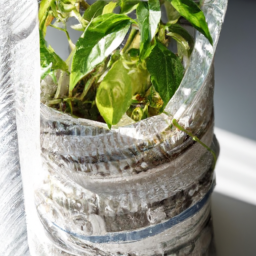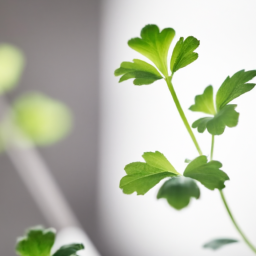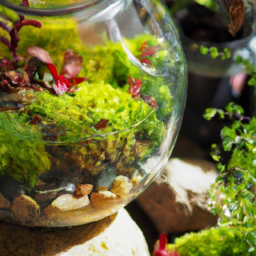
Terrariums have become increasingly popular in recent years, and it’s no wonder why. The art of terrariums allows us to create mini ecosystems indoors, bringing a touch of nature into our homes. These miniature gardens not only add a unique and beautiful aesthetic to any space but also provide a sense of tranquility and connection with the natural world. Whether you have a green thumb or struggle to keep plants alive, terrariums offer a low-maintenance and rewarding way to bring the outdoors in. In this blog post, we will explore the art of terrariums, from the basics of building one to the different types of plants that thrive within these miniature worlds. So, let’s dive into the enchanting world of terrariums and discover how to create our own mini ecosystems indoors.
The Benefits of Terrariums: How Mini Ecosystems Improve Indoor Air Quality
Welcome to the wonderful world of terrariums! In this article, we will explore the art of creating mini ecosystems indoors and how they can significantly improve the air quality in your home or office. Terrariums not only add a touch of greenery to your space but also offer numerous health benefits by purifying the air you breathe. So, let’s dive in and discover the fascinating benefits of these miniature gardens!
Understanding Terrariums
Before we delve into the benefits of terrariums, let’s first understand what they are. A terrarium is a sealed or partially enclosed glass container that houses a variety of plants, creating a self-sustaining ecosystem. These mini indoor gardens are designed to mimic the natural conditions required for plant growth, including sunlight, moisture, and air circulation.
The Science behind Improved Air Quality
Now, let’s explore how terrariums can enhance the air quality in your indoor spaces. Plants, as we know, play a crucial role in converting carbon dioxide into oxygen through photosynthesis. However, they also possess another remarkable ability: air purification. Through a process called phytoremediation, plants can remove harmful toxins and pollutants from the air, making it cleaner and healthier to breathe.
When it comes to air purification, terrariums excel due to their enclosed nature. The glass container acts as a greenhouse, trapping and recycling moisture and nutrients within the ecosystem. As the plants respire, they release water vapor, which condenses on the glass walls and trickles back down, maintaining a continuous water cycle. This process, known as transpiration, helps humidify the air and prevents dryness, especially during winter months when indoor heating can cause discomfort.
Furthermore, the soil and microorganisms present in a terrarium contribute to air purification. The soil acts as a natural filter, trapping and breaking down pollutants such as formaldehyde, benzene, and xylene, commonly found in household items like paint, furniture, and cleaning products. The microorganisms, including bacteria and fungi, present in the soil also play a vital role in neutralizing harmful chemicals, creating a healthier environment.
Benefits of Terrariums for Indoor Air Quality
Now that we understand the science behind it, let’s explore the specific benefits of terrariums for improving indoor air quality:
1. Removal of Airborne Toxins
Terrariums act as natural air filters, effectively removing harmful airborne toxins. The plants absorb these toxins through their leaves and roots, breaking them down into harmless byproducts. This process significantly reduces the concentration of pollutants in the air, creating a cleaner and healthier environment for you to breathe in.
2. Increased Oxygen Production
As mentioned earlier, plants release oxygen during photosynthesis. By having a terrarium in your indoor space, you introduce an additional source of oxygen, which can boost your overall well-being. Increased oxygen levels can improve cognitive function, reduce stress, and enhance your mood, leading to a more productive and positive environment.
3. Humidity Regulation
One of the key advantages of terrariums is their ability to regulate humidity levels. The enclosed glass container helps retain moisture within the ecosystem, preventing excessive dryness in the air. This is particularly beneficial during dry seasons or in regions with low humidity. By maintaining optimal humidity, terrariums can alleviate respiratory issues, dry skin, and even reduce the spread of airborne viruses.
Creating Your Own Terrarium
Now that you’re aware of the incredible benefits of terrariums, why not try creating one yourself? Follow these simple steps to get started:
Step 1: Selecting the Container
Choose a glass container that suits your style and space. It can be a fish tank, a mason jar, or even a repurposed glass bottle. Just ensure that it has a lid or can be covered partially to create the desired enclosed environment.
Step 2: Choosing the Right Plants
Opt for plants that thrive in humid and low-light conditions. Some popular choices for terrariums include ferns, mosses, air plants, and succulents. Be mindful of the size and growth habits of the plants to ensure they fit comfortably within the container.
Step 3: Creating the Layers
Start by adding a layer of gravel or small rocks at the bottom of the container. This will provide drainage and prevent water from accumulating. On top of the gravel, add a layer of activated charcoal to absorb any odors or toxins. Then, add a layer of sphagnum moss to separate the soil from the drainage layer. Finally, add a layer of potting soil, leaving enough space for the plants to be placed.
Step 4: Planting and Maintenance
Plant your selected plants in the soil, ensuring they are appropriately spaced and arranged for aesthetic appeal. Once planted, water the terrarium sparingly, as the enclosed environment requires less frequent watering compared to traditional potted plants. Monitor the moisture levels and adjust accordingly. Prune and trim the plants as needed to maintain their shape and prevent overcrowding.
And voila! You have successfully created your own mini ecosystem indoors. Enjoy the beauty of nature while reaping the benefits of improved air quality!
Conclusion
Terrariums are not just decorative pieces; they are living, breathing ecosystems that offer numerous benefits. By improving indoor air quality, terrariums can enhance your overall well-being, boost productivity, and create a healthier living or working environment. So, why not give it a try? Create your own mini ecosystem and experience the wonders of nature indoors!
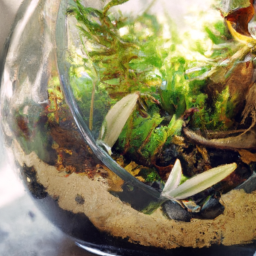
The Art of Terrariums: Mini Ecosystems Indoors
2. A Step-by-Step Guide to Creating Your Own Terrarium: Materials, Plants, and Care Tips
Welcome to the wonderful world of terrariums! Creating your own mini ecosystem indoors is not only a fun and creative activity but also a great way to bring a touch of nature into your living space. In this step-by-step guide, we will walk you through the process of making your own terrarium, from choosing the right materials to selecting the perfect plants and providing proper care.
Materials
Before diving into the creation process, it’s important to gather all the necessary materials. Here’s what you’ll need:
Glass Container: The first step is to select a suitable glass container for your terrarium. It can be a fish tank, a glass jar, or even a repurposed glass container. Just make sure it has a lid or can be covered to create a humid environment.
Gravel or Pebbles: The gravel or pebbles will serve as the bottom layer of your terrarium, providing drainage for excess water. Choose small-sized pebbles to create a stable base.
Activated Charcoal: Activated charcoal helps to filter the air and prevent any unwanted odors. It also aids in keeping the terrarium free from bacteria and fungi. You can find activated charcoal at garden centers or pet stores.
Potting Soil: Select a high-quality potting soil that is well-draining but also retains moisture. Avoid using soil from your garden, as it may contain pests or diseases.
Plants: The choice of plants is crucial for a successful terrarium. Opt for plants that thrive in humid environments and have similar light and water requirements. Some popular choices include ferns, mosses, succulents, and air plants.
Decorative Elements: To add a personal touch to your terrarium, consider incorporating decorative elements such as small figurines, rocks, or pieces of driftwood. These can enhance the overall aesthetic appeal.
Creating Your Terrarium
Now that you have all the materials ready, it’s time to start building your terrarium. Follow these steps:
Step 1: Clean the Container: Ensure the glass container is clean and free from any dirt or residue. This will provide a clear view of your mini ecosystem.
Step 2: Add a Layer of Gravel: Begin by adding a layer of gravel or pebbles to the bottom of the container. This will help with drainage and prevent waterlogging.
Step 3: Place Activated Charcoal: Sprinkle a thin layer of activated charcoal on top of the gravel. This will purify the air and prevent any unpleasant odors.
Step 4: Add Potting Soil: Carefully add a layer of potting soil on top of the charcoal. Make sure it is deep enough to accommodate the root systems of your chosen plants.
Step 5: Plant Selection and Placement: Now comes the exciting part – choosing and placing your plants. Start by creating small holes in the soil to accommodate the plant roots. Gently remove the plants from their pots, loosen the roots if necessary, and place them in the holes. Arrange them in a visually pleasing manner, considering their growth habits and heights.
Step 6: Finishing Touches: Once the plants are in place, you can add decorative elements to enhance the terrarium’s visual appeal. Be creative and experiment with different arrangements to achieve the desired look.
Care Tips
Caring for your terrarium is relatively easy, but it’s important to provide the right conditions for your mini ecosystem to thrive. Here are some care tips:
Light: Most terrarium plants prefer indirect or filtered sunlight. Place your terrarium in a location that receives bright, indirect light, such as near a north or east-facing window.
Watering: The key to successful watering is finding the right balance. Monitor the moisture level in your terrarium by touching the soil. If it feels dry, it’s time to water. Use a spray bottle or a watering can with a narrow spout to provide a gentle misting. Avoid overwatering, as it can lead to root rot.
Pruning: Regular pruning is essential to maintain the desired shape and prevent overcrowding. Trim any yellow or dead leaves, and prune back any plants that have outgrown their space.
Humidity: Terrariums create a humid environment, but if you notice excessive condensation on the glass, it’s a sign of too much moisture. Remove the lid temporarily to allow excess moisture to evaporate.
Fertilizing: Most terrariums do not require frequent fertilization. However, if you notice slow growth or pale leaves, you can use a diluted, balanced liquid fertilizer during the growing season. Follow the instructions on the fertilizer package for the correct dosage.
With these step-by-step instructions and care tips, you are now well-equipped to create and maintain your own beautiful terrarium. Enjoy the process, get creative, and watch as your mini ecosystem thrives and brings a touch of nature into your indoor space!
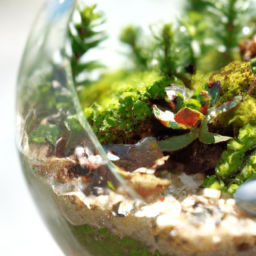
Exploring Different Terrarium Designs: From Open to Closed, Desert to Rainforest
Terrariums are miniature ecosystems that allow you to bring the beauty of nature indoors. They come in various designs, each suited for different plant species and environments. In this article, we will explore three types of terrarium designs: open, closed, and specialized terrariums for desert and rainforest plants. So, let’s dive in and discover the art of creating these captivating mini ecosystems.
Open Terrariums: Embracing Air Flow and Low Humidity
Open terrariums are the most common type and are ideal for plants that thrive in drier conditions. These terrariums have an opening or lack a lid, allowing for better air circulation and preventing excessive humidity buildup. Follow these steps to create your own open terrarium:
Step 1: Choose the Right Container
Select a glass container that suits your aesthetic preferences. You can use a fish tank, a glass jar, or even a repurposed glass container. Ensure it has no cracks or leaks, as a proper seal is essential for closed terrariums, not open ones.
Step 2: Create a Drainage Layer
Add a layer of small rocks or pebbles at the bottom of your container. This layer helps with drainage and prevents water from pooling at the roots of your plants.
Step 3: Add Activated Charcoal
Place a thin layer of activated charcoal on top of the drainage layer. Activated charcoal helps to filter the air and prevent any unpleasant odors from developing within the terrarium.
Step 4: Add Potting Soil
Next, add a layer of potting soil on top of the charcoal. Choose a well-draining soil mix suitable for the types of plants you plan to include in your terrarium.
Step 5: Select and Arrange Your Plants
Now comes the fun part – selecting and arranging your plants. Opt for plants that prefer drier conditions, such as succulents, cacti, or air plants. Consider their growth habits, colors, and textures when arranging them within the terrarium.
Step 6: Decorate and Water
Add decorative elements like small rocks, moss, or figurines to enhance the visual appeal of your terrarium. Once you’re satisfied with the arrangement, water your plants sparingly, ensuring not to overwater them. Monitor the moisture levels and adjust watering accordingly.
Closed Terrariums: Capturing Moisture and Creating a Self-Sustaining Environment
Closed terrariums create a self-sustaining ecosystem by trapping moisture inside. These terrariums are perfect for plants that thrive in high humidity environments. Follow these steps to create your own closed terrarium:
Step 1: Choose the Right Container
Similar to open terrariums, select a glass container that suits your style. However, for closed terrariums, it’s crucial to ensure the container has a tight-fitting lid to create a sealed environment.
Step 2: Create a Drainage Layer
As with open terrariums, add a layer of small rocks or pebbles at the bottom to facilitate drainage and prevent waterlogging.
Step 3: Add Activated Charcoal
Place a thin layer of activated charcoal on top of the drainage layer. The charcoal helps to filter the air and keep it fresh within the closed environment.
Step 4: Add Moisture-Loving Soil
Unlike open terrariums, closed terrariums require a soil mix that retains moisture. Use a well-draining soil with a higher organic matter content to ensure proper water retention.
Step 5: Select and Arrange Your Plants
Choose plants that thrive in high humidity, such as ferns, mosses, or tropical plants. Consider their growth habits and ensure they are compatible in terms of light and water requirements.
Step 6: Decorate and Seal
Add decorative elements like small figurines, colorful stones, or pieces of driftwood to create a visually appealing terrarium. Once you’re satisfied, seal the container tightly to create a closed environment.
Step 7: Monitor and Maintain
Unlike open terrariums, closed terrariums require minimal watering due to the self-sustaining nature of the ecosystem. However, monitor the moisture levels and open the lid occasionally to release excess humidity and prevent mold growth.
Specialized Terrariums: Desert and Rainforest Environments
For those looking to create terrariums specifically designed for desert or rainforest plants, there are specialized terrariums available. These terrariums mimic the unique conditions found in these environments, allowing you to cultivate plants that require specific care. Here’s a brief overview of these specialized terrariums:
Desert Terrariums:
Desert terrariums replicate arid conditions and are perfect for succulents and cacti. They require well-draining soil, ample sunlight, and minimal watering. Consider using sand or gravel as the primary substrate to mimic desert landscapes.
Rainforest Terrariums:
Rainforest terrariums recreate the humid and lush environment found in tropical rainforests. These terrariums are ideal for ferns, orchids, and other moisture-loving plants. Use a well-draining soil mix with higher organic matter content, provide indirect sunlight, and maintain higher humidity levels.
By exploring different terrarium designs, you can create captivating mini ecosystems that not only add a touch of nature to your indoor space but also provide a rewarding gardening experience. Whether you opt for an open terrarium, closed terrarium, or a specialized desert or rainforest terrarium, remember to choose plants that suit the specific environment and enjoy the process of watching your mini ecosystem thrive.
Highlights of this article
Terrariums, those captivating miniature ecosystems enclosed in glass, have become quite the trend lately. And it’s no wonder why! These little indoor gardens offer a unique and low-maintenance way to bring a touch of nature into our homes. Whether you have a green thumb or not, creating and caring for a terrarium is a delightful and rewarding experience.
Terrariums come in all shapes and sizes, from simple and minimalist to lush and vibrant. The beauty lies in their versatility and the endless possibilities for creativity. The key to a successful terrarium lies in understanding the needs of the plants you choose and creating a balanced ecosystem within the glass walls. By carefully selecting the right plants, providing adequate light and moisture, and maintaining the proper conditions, you can create a thriving mini garden that will bring joy and tranquility to your space. So, why not give it a try? With a little patience and some creativity, you can master the art of terrariums and enjoy the beauty of nature right at your fingertips.
Here are some questions from our readers:
Q1: What is a terrarium?
A1: A terrarium is a small, enclosed ecosystem that replicates the natural environment of plants and sometimes small animals. It typically consists of a glass container or jar, filled with soil, plants, and sometimes decorative elements like rocks or figurines.
Q2: How do terrariums work?
A2: Terrariums work by creating a self-sustaining environment where plants can thrive. The glass container traps moisture, creating a miniature water cycle. The plants release moisture through transpiration, which then condenses on the container walls and drips back down, providing hydration. This closed system reduces the need for frequent watering.
Q3: What plants are suitable for terrariums?
A3: Various plants can thrive in terrariums, but it’s important to choose those that prefer high humidity and low light conditions. Some popular options include ferns, mosses, air plants, fittonias, and pothos. It’s best to select plants with similar care requirements to ensure they coexist harmoniously.
Q4: How do I care for a terrarium?
A4: Terrariums are relatively low-maintenance, but they do require some care. Here are a few tips:
– Place your terrarium in an area with indirect sunlight, as direct sunlight can cause overheating.
– Monitor the moisture levels by checking condensation on the glass. If it’s too dry, lightly mist the plants or add a small amount of water.
– Trim any overgrown or decaying plant material to maintain a healthy environment.
– Keep an eye out for pests and remove them promptly if spotted.
– Open the terrarium occasionally to allow fresh air circulation, but be mindful not to disrupt the humidity balance.
Q5: Can I create my own terrarium?
A5: Absolutely! Creating your own terrarium can be a fun and rewarding experience. Start by selecting a suitable glass container, then add a layer of rocks or pebbles for drainage. Next, add activated charcoal to prevent odors and mold growth. Top it with a layer of potting soil and carefully plant your chosen greenery. Finally, add any decorative elements and mist the plants with water. Voila! You have your very own mini ecosystem indoors.
Dr. Olivia Green is a botanist with over two decades of experience in indoor plant cultivation. She holds a Ph.D. in Plant Biology and has dedicated her career to researching plant behavior in controlled environments. Dr. Green is passionate about helping plant enthusiasts master the art of indoor gardening through her extensive knowledge and practical insights.

